SENSUOUS SIMPLICITY
A repeat of Julia Reed’s New York Times article on me as “The Comeback Kid” but with my recipes with photos for Passion-Fruit Curd Brûlée, Chateau d’Yquem, and Montpelier Butter.
In March 2023 the great and late writer and Newsweek magazine correspondent Julia Reed wrote an article about me in the New York Times.
And about her friendship with Bobby Harling the author of Steel Magnolias. Julia was definitely a steel magnolia herself. And impressed that he knew about an aside “in Tower's first book, New American Classics.
Where “Tower wrote about the merits -- and the decadence -- of drinking Château d'Yquem with a ''rich, aged, perfectly cooked roast beef.''
Photo Courtesy of Sam Hanna
“I had puzzled over Tower's audacious combination for years. And I was delighted -
Photo Courtesy of Sam Hanna
when Bobby proposed that we try it carefully following the instructions about ''chewing the beef and taking a draft of the wine, chewing twice and swallowing,'' It was every bit as ''rapturous'' and life-changing as Tower promised it would be. That meal not only cemented my friendship with Bobby; it also upheld my conviction that Tower is a genius.”
"By then Tower had already changed the landscape of American cuisine as part owner and head chef at Chez Panisse in Berkeley. He had also created Stars in San Francisco, one of the world's great restaurants, a fabulous, improbably intimate ''grand cafe'' in the style of the restaurant La Coupole in Paris when it was still cool, but with incredible, then-new food, like salmon tartare and grilled duck with mango-chili salsa, Tower's famous black-bean cake and tiny, perfect pizzas at the bar. I loved Stars, and I used New American Classics like a bible, but even before that, I was saved from poverty by Time-Life's ''Good Cook'' series, for which Tower served as consultant under the great Richard Olney.
I augmented my meager wages at Newsweek selling those ''Good Cook'' books over the phone. I was only 20, but I knew they were something special -- with their historical references and brilliantly curated recipes from all over the world and their clear photos that served as foolproof step-by-step guides through endless dishes and techniques (photos that, I later found out, had been Tower's doing. By the time I finally got a degree, I had very little recollection of what I had learned in classes, but I possessed an impressive repertory of dishes that I could make entirely from the memory of the pictures in those volumes, called simply ''Salads'' or ''Pasta'' or ''Desserts.''
When Tower sold Stars in San Francisco and went off to the Far East to open versions of it there, I thought his recipes were all that I would have left of my hero. But then he is back with Jeremiah Tower Cooks.
A collection of 250 recipes, charming anecdotes about his well-traveled life and invaluable insights for the home cook, ranging from why you should never plunge vegetables into an ice bath (''You might as well save yourself the time and trouble and buy frozen ones instead'') to what is wrong with all those ''sprigs of fresh herbs sticking out of the top of every dish today'' (''Let's decide that garnishes . . . should be edible and an integral part of the dish'').
Tower is refreshingly straightforward, but he has definitely retained his decadent side.
In this book, there's an oyster soup that takes only 15 minutes to make, but its key ingredient is osetra caviar. And a sea urchin soufflé Tower once baked, in its own shell, for James Beard, who pronounced it the best thing he ever tasted. There's a section on sandwiches that begins modestly enough with a chicken club and an open-faced egg salad, but the one I intend to try first is the open-faced foie gras, consisting of a slice of foie gras on toasted brioche, topped with a tangle of arugula leaves tossed with chopped preserved lemon, hazelnut oil and cardamom. There are directions for making the perfect hamburger and a list of toppings, including a simple one of sour cream mixed with coarsely ground black pepper. But on the next page there's a recipe for a truffled burger that he recommends having with ''a luscious, old-fashioned, rich and powerful red wine -- in a large balloon glass,'' lest the burger ''falls short of its overwhelming effect.''
These days burgers with black truffles are all the rage. But Tower first wrote about them, for me, when I was an assigning editor at Vogue in December 1988. (I remember being so happy when I read the first line of that article -- ''Christmas seems so obvious'' -- because I knew something good was going to follow, and it did.)
Tower can really write, and it is not surprising, since he counts among his influences the wonderful English food writer Elizabeth David. But he was also inspired by Escoffier and Olney and Beard, and by his colorful Russian aunt and uncle who taught him the pleasures of everything from a rustic coleslaw to caviar and blini.
The result is a cuisine I call sensuous simplicity.
Also, even though Tower is nothing if not modern, he knows that there are not, in fact, all that many ways to skin a cat, that it is still way worth knowing how to make a flawless hollandaise sauce, a mousse like green-goddess mayonnaise, real Russian dressing with horseradish and caviar.
One of my favorite recipes in the whole book is for Montpelier butter -- it's the best version I've ever tried and incredibly versatile. In New American Classics Tower writes that this classic compound butter ''transforms hot cauliflower'' and that ''on top of mashed potatoes it is so good that it should be arrested.'' Here he says he hasn't changed his mind and further recommends it with hot grilled fish or steaks and, at room temperature, with cold poached salmon. With typical passion, he adds that when it is spooned between slices of leftover roast pork or veal ''with the slices reassembled, left for a day, and then eaten at cool room temperature, it creates a lifelong memory.
Montpelier Butter
This greatest of all “compound” butters is traditionally made in a mortar with a pestle, but a food processor will do just fine.
It is very good with cold poached fish, especially salmon, but is equally delicious with hot grilled or roasted fish. Spooned between slices of cold roast veal or pork, the slices reassembled, left for a day, and served at room temperature, it creates a lifelong memory.
Here I serve it with a simple piece of roast salmon. The butter will keep in the fridge for a few days and can be froze for a month - perfect to have on hand the next time you want to enhance a simple protein.

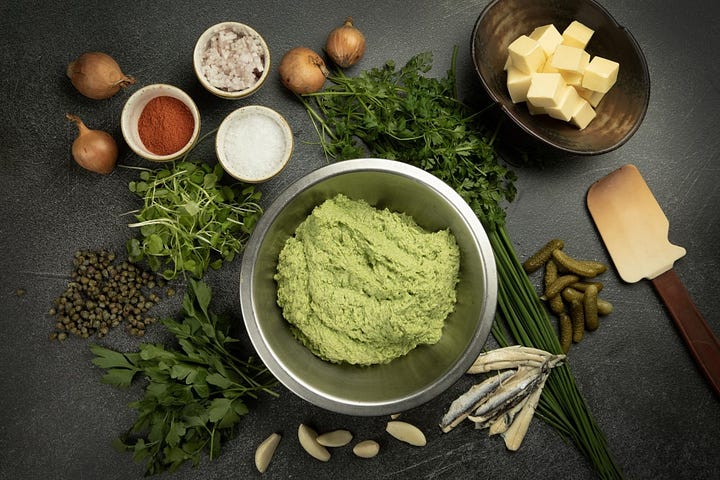
Photo Courtesy of Andee Gosnell & The Herald
Yield: 1 1/2 to 2 cups.
6 leaves spinach
Leaves from 1/2 bunch watercress (1 1/2 cups of leaves)
2 tablespoons fresh flat parsley leaves
2 tablespoons fresh chervil leaves
2 tablespoons chopped fresh chives
1 tablespoon fresh tarragon leaves
2 shallots, chopped
2 cornichons, rinsed and chopped
4 anchovy fillets
2 tablespoons capers
1 garlic clove, peeled
1/4 teaspoon cayenne pepper
3 hard-cooked egg yolks
2 large raw egg yolks
1/4-pound unsalted butter, at room temperature, cut into 1-tablespoon pieces
1/2 cup extra-virgin olive oil
1 teaspoon white-wine vinegar
Salt and freshly ground white pepper.
Blanch the spinach, watercress, herbs and shallots in boiling water for 1 minute. Drain, refresh under cold water and squeeze dry. Place the mixture in a food processor. Add the cornichons, anchovies, capers, garlic, cayenne and salt and pepper. Process to a smooth paste. Add the egg yolks, cooked and raw, and the butter and process again until thoroughly mixed.
If the butter is still a little chunky (the sauce should be glossy and smooth as velvet), transfer the mixture to a blender and beat in the oil in a thin steady stream while the blender is running. If the mixture is perfectly smooth in the food processor, transfer the butter to a bowl and whisk in the oil by hand. Beat in the vinegar and adjust salt and pepper to taste.
Another recipe from Jeremiah Tower Cooks is: Passion-Fruit Curd Brûlée
Photo Courtesy of Facebook
Yield: 4 servings
4 eggs
2 egg yolks
1 cup fresh passion-fruit juice (from about 6 large ripe fruits, pulp removed, puréed in a blender for 1 minute and sieved; see note)
2 tablespoons fresh lime juice
1/4 cup heavy cream
1 cup sugar
Pinch of salt
1/2 cup unsalted butter, at room temperature, cut into 1-tablespoon pieces
1/4 cup superfine sugar
Combine all the ingredients except the butter and superfine sugar in a metal nonreactive bowl and beat together until the 1 cup of sugar is completely dissolved. Prepare an ice bath in a bowl slightly bigger than the bowl used to beat the ingredients. Put the bowl with the egg mixture over simmering water and cook, beating constantly, for 10 minutes, or until the curd thickens, being careful not to let the egg mixture curdle. Beat in the butter. Transfer the bowl to the ice bath and beat the curd until it is cold, about 5 minutes.
Spoon the curd into four cold, shallow gratin dishes. Cover and refrigerate for at least 2 hours.
When ready to serve, heat the broiler to maximum heat. Spread 1 1/816 inch of superfine sugar evenly over the surface of each dish. Place under broiler close to flame until the sugar caramelizes. (You can also use a mini-blowtorch.) Serve immediately.
Thank you for reading Out of the Oven. If you upgrade for the whole experience, and pay $5 a month or $50 a year, you will receive at least weekly publications, as well as menus, recipes, videos of me cooking, and full access to archives.


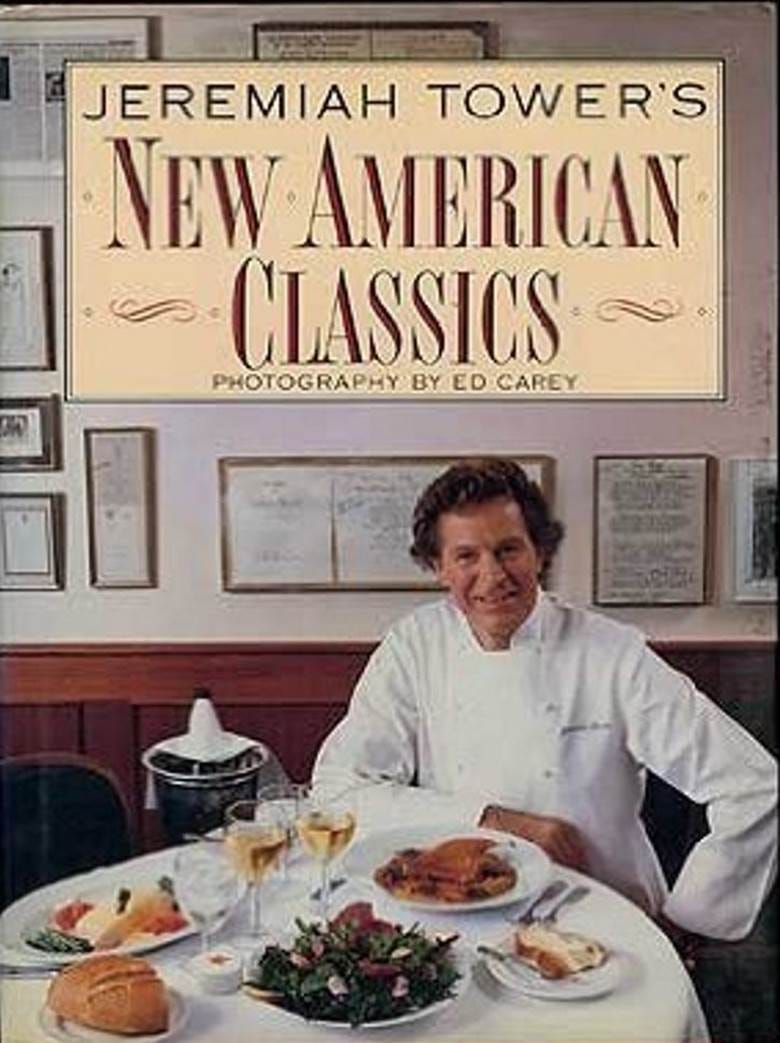
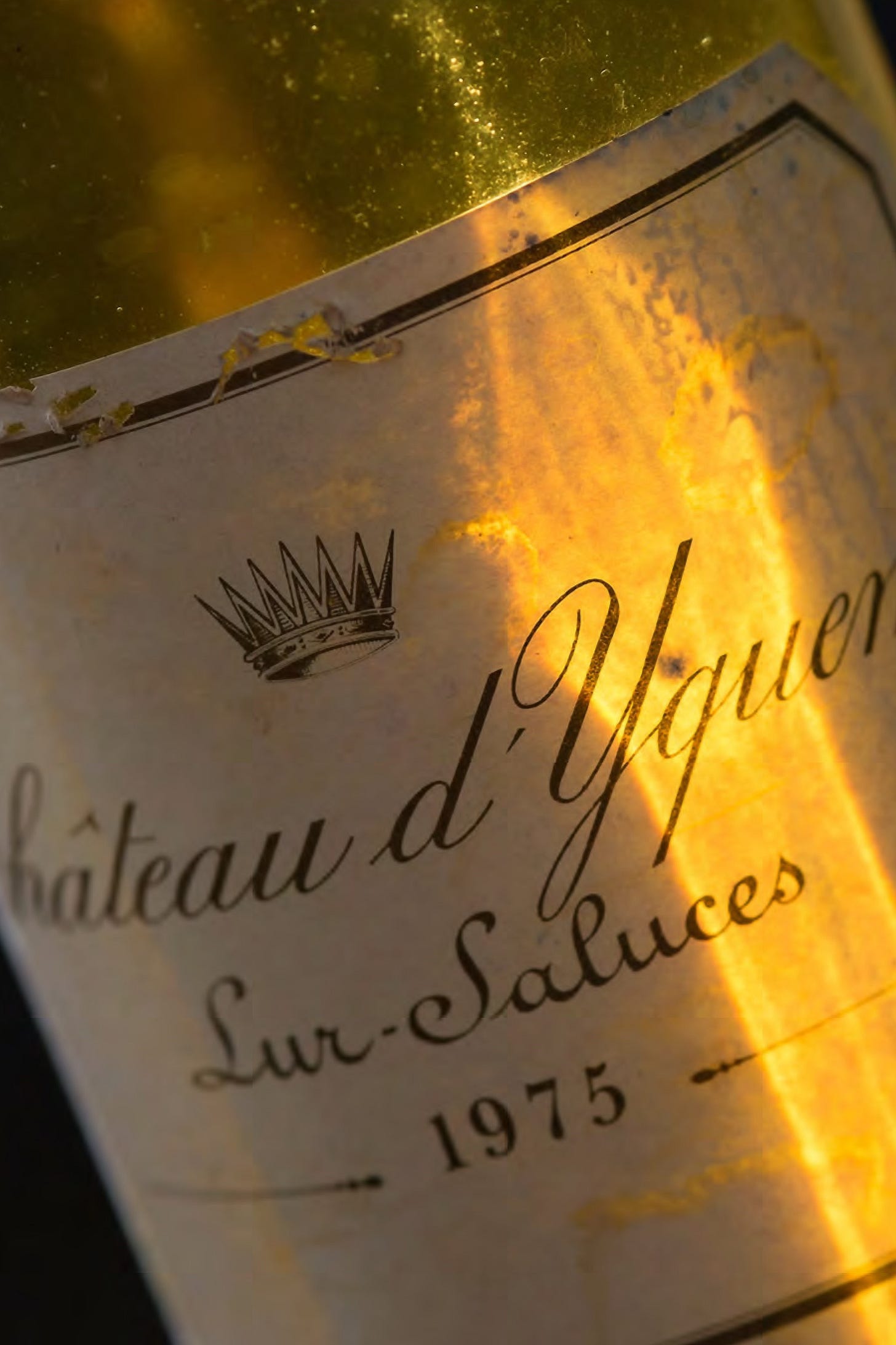
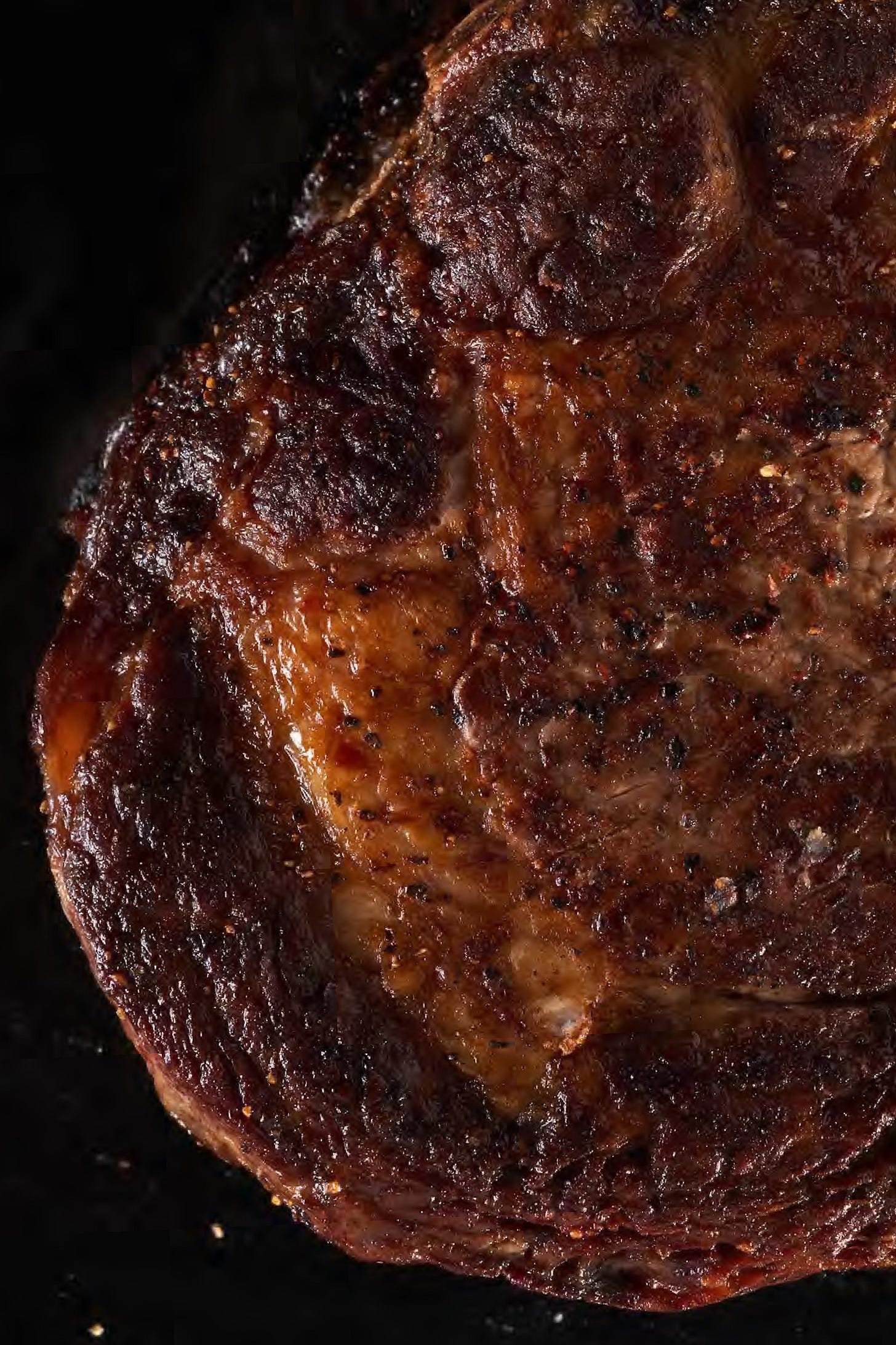

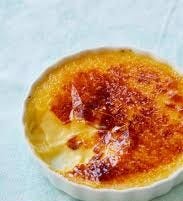
Thank you Bernadette. I miss the champagne and oysters!
Bien sur always a good thing. As are your comments.